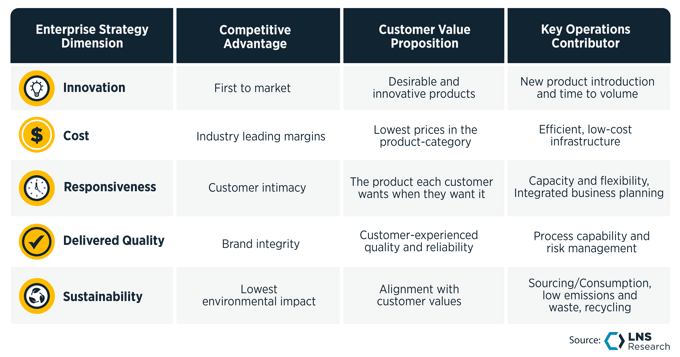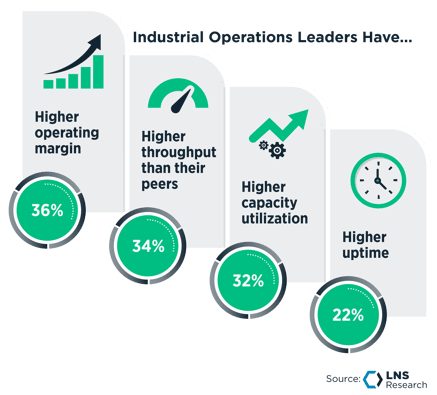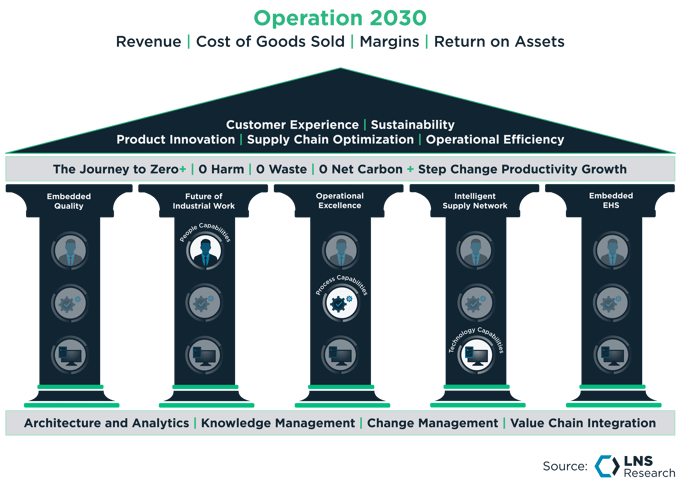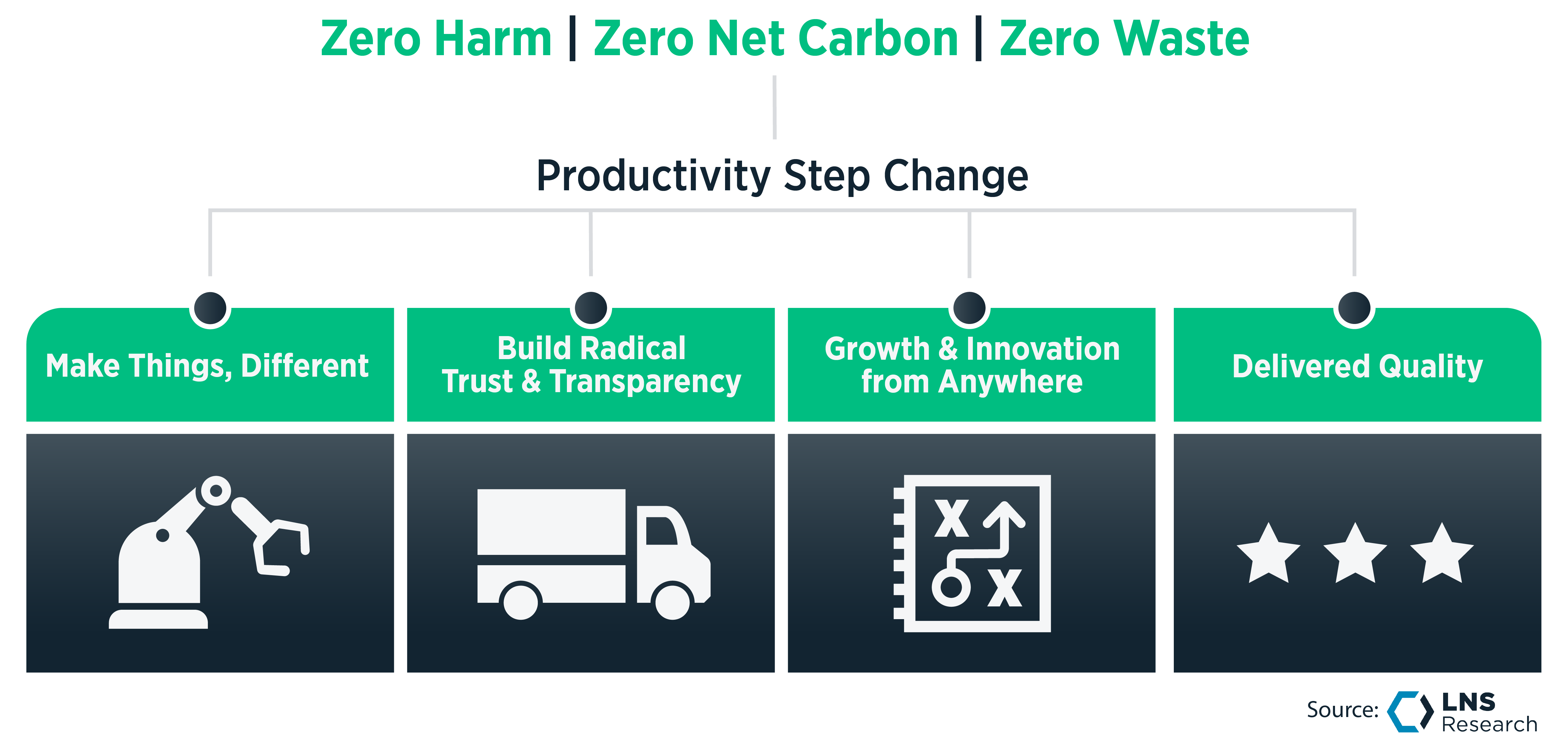Have you ever been told that the only objectives in manufacturing are to cut costs and deliver products? If you have, then you are not alone.
While it's evident that manufacturers need to produce goods, the process of “making the products” is often viewed as tactical. As a result, many believe the sole purpose of manufacturing operations is cost reduction. Throughout my career, I have learned that this view is too narrow, and now our research shows that a well-run industrial operation can be a significant strategic advantage.
Defining Key Terms
There are three key terms we need to define before we dive into the details:
-
-
-
Industrial Operations: The totality of processes involved in the sourcing, production, and distribution of goods; this extends beyond the manufacturing plant walls.
-
Enterprise Strategy: A high-level plan devised by an enterprise to achieve long-term goals, focusing on direction, market positioning, and competitive advantage.
-
Industrial Operations Strategy: A strategy aligned with and supporting the Enterprise Strategy, focusing on transforming and optimizing Industrial Operations to achieve business objectives. It is not a stand-alone strategy but a detailed extension of the enterprise strategy.
The primary purpose of an Industrial Operations Strategy is to help the Chief Operations Officer (COO) and the supporting organization make choices that enable operations to deliver what the enterprise needs and empower the enterprise to use operational capabilities to become more productive and effective in navigating the market and serving customers.
The starting point of any strategy development is a solid understanding of the enterprise’s mission and vision, which lays the foundation for all other choices. The mission and vision act as the constitution of the strategy, providing a framework for making choices and interpreting the choices that have been made. An example is the importance the enterprise places on zero harm, zero waste, and sustainability, which lays the foundation for the prioritization of many subsequent choices.
In an enterprise with limited resources (all enterprises fall into this category; if you don’t think you are, then you are fooling yourselves), it is critical to understand what you will say YES and NO to. You have probably observed leaders creating a promising vision, only to realize that they have over-promised and under-delivered, with devastating results to the organization. Too many people believe that building a strategy is to say yes to as many things as possible, whereas in reality, strategy is about being effective and doing the right things exceptionally well.
A good strategy must look beyond the needs of day-to-day operations to achieve step change productivity growth. It is important to make the right choices as they relate to the primary enterprise strategies of innovation, cost, responsiveness, and delivered quality. The LNS Research Strategy Prioritization Framework can help you understand where to use your resources.
Figure 1: LNS Research Industrial Operations Strategy Prioritization Framework
Why the Industrial Operations Strategy Matters
So, why should you care about this? I am sure we have all experienced how the world is changing at a faster rate than before:
-
-
-
Outside the company, you have likely seen large shifts in buyer behavior, competitive innovations, new opportunities through disruptive technologies, supply chain upsets, government regulations, inflation, geopolitical instability, and sustainability expectations.
-
Inside the company, you may have experienced the impact of the changing workforce; many workers have gone from wanting a career in manufacturing to just wanting a job. The average experience of a front-line employee has dropped dramatically, leading to more safety incidents, reduced quality, and lower productivity.
The increased rate of change heavily impacts Industrial Operations. While in the past, it was perceived to be OK to just maintain the status quo, we now see that the inability to adapt to and leverage the changing world causes results to go backward.
However, some companies know how to navigate a changing world, and the results are quite astonishing. On average, companies that implement a sound Industrial Operations Strategy have 36% higher operating margins, 34% higher throughput, 32% higher capacity utilization, and 22% higher uptime than those that do not.
Figure 2: Industrial Operations Leaders Outperform the Followers
Both the Bureau of Labor Statistics and LNS Research’s productivity data agree that most manufacturing companies have seen stagnation in productivity growth; however, these Industrial Operations Leaders have effectively bucked the trend and accelerated away from the rest.
Charles Darwin famously said, “It is not the strongest of the species that survives, nor the most intelligent, but the one most responsive to change.” The same can be said about Industrial Operations.
Building an Industrial Operations Strategy allows COOs to envision a future that can be fed back into the enterprise strategy and position Industrial Operations as a strategic part of the business with a strong seat at the table. This can allow companies to create new products, enter new markets, and add competitive advantages.
What Does Such a Strategy Look Like?
An example of such a strategy is the Journey to Zero+; we call this strategy Operation 2030.
Figure 3: Building Your Industrial Transformation Strategy
This strategy provides a holistic template for the components necessary for success and enables the COO to deliver results. It is built on a strong foundation and five core pillars representing strategic transformation initiatives to achieve 0 Harm, 0 Waste, 0 Net Carbon, and Step Change Productivity Growth. While achieving Zero+ may be a challenge, the goals are still real, as no one should have a goal to “only injure one person” or have even a “small negative impact on the environment.” These business objectives set the strategic direction for the enterprise.
The success criteria of such a strategy are:
-
-
-
End-to-end operating model that optimizes productivity.
-
A clear understanding of your burning platform.
-
Balance value preservation & value creation.
These criteria emphasize the need to understand the whole and the details to make the strategy actionable.
How Are Industrial Operations Leaders Different from Others?
Our research shows that leading manufacturing companies' strategies differ in how they view the role of Industrial Operations. We see distinct differences in the leaders’ products and production processes, how they collaborate across the supply chain, how they are organized, and how they view the importance of quality.
Figure 4: Leaders' Different Approach to Industrial Operations
We have identified four areas where leaders take a different approach:
-
They make things, different. They have unique products and production processes.
-
They build radical trust and transparency across the value chain. They collaborate closely with suppliers and customers. Changes outside the four walls of manufacturing trigger many of the benefits.
-
They enable growth and innovation from everywhere. They have one culture, a clear Industrial Operations leader, and a clear strategy aligned with the enterprise strategy.
-
They excel in customer-experienced quality. They reduce variance and consistently manufacture great products that meet customer needs.
All these elements are built on transforming people, processes, and technologies to deliver a step change in productivity.
The Next Steps for COOs
If you want to build an Industrial Operations Strategy, then there are several steps you can take today to prepare for building an Industrial Operations Strategy:
-
Review the Enterprise Strategy with operations in mind. Ask yourself: "How can I enable the Enterprise Strategy, and how can I empower the Enterprise to grow beyond the strategy?"
-
Identify the degree to which each of the primary Enterprise Strategies is important for your company:
-
Innovation
-
Cost
-
Responsiveness
-
Delivered Quality
- Sustainability
-
Challenge the current state of operations. Identify how you can:
-
Make things, different
-
Build radical trust and transparency across the value chain
-
Enable growth and innovation from everywhere
-
Excel in customer-experienced quality
-
Plant the seed with the CEO and the executive team that an Industrial Operations Strategy can be a game changer.
-
Get ready to build the Industrial Operations Strategy.
Further reading
